Physical Address
304 North Cardinal St.
Dorchester Center, MA 02124
Physical Address
304 North Cardinal St.
Dorchester Center, MA 02124
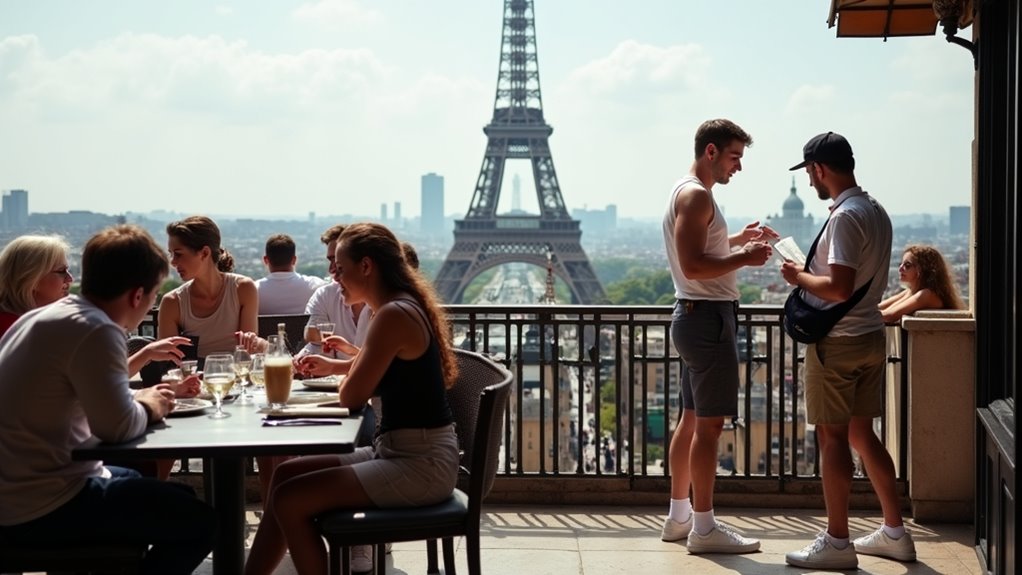
Blunders while visiting Paris can ruin your trip, but knowing these 11 crucial mistakes will transform your experience.
When visiting Paris, avoid skipping “Bonjour” greetings in shops, overscheduling tourist attractions, eating near landmark sites, relying solely on the Métro, ignoring French meal times, neglecting pickpocket awareness, and missing neighborhood exploration beyond famous sites. Always carry some cash for small purchases, and dress appropriately for upscale venues. Remember that quality experiences trump quantity, so build in downtime for spontaneous discoveries. These insider tips will transform your Parisian adventure.
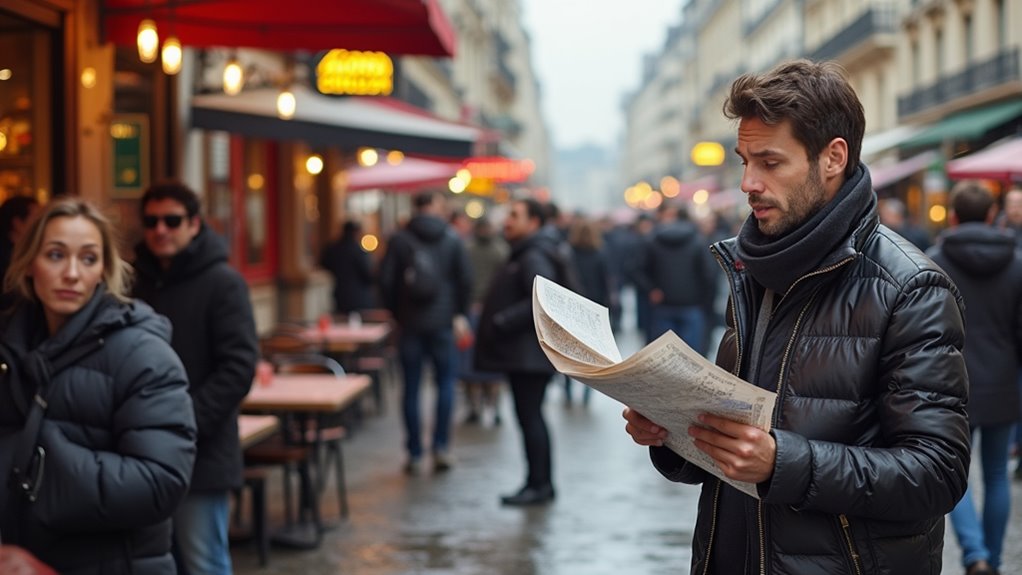
When visiting Paris, rushing through attractions is perhaps the biggest mistake travelers make. You’ll miss the essence of the city by cramming too many sites into your itinerary.
The Louvre alone demands several hours with its 9+ miles of galleries—not the quick hour many travelers allocate.
Don’t underestimate the value of downtime between activities. Those moments sitting at cafés or strolling along the Seine often become cherished memories.
Make advance reservations for popular attractions like the Eiffel Tower to avoid wasting precious hours in queues. Always begin interactions with staff by saying bonjour or bonsoir depending on the time of day to avoid unintentionally offending locals.
Look beyond tourist hubs like Montmartre. The authentic Paris awaits in lesser-known neighborhoods where locals actually live. As with essential travel tips in any major city, respecting local customs will enhance your Parisian experience.
Remember: quality experiences trump quantity every time. You’ll enjoy Paris more by seeing fewer sights thoroughly than racing through a checklist.
Walking into a Parisian shop without saying “Bonjour” immediately marks you as an outsider who hasn’t done their homework. The French social protocol demands this verbal greeting before any transaction can begin.
In Paris, the absence of “Bonjour” upon entering a shop reveals cultural ignorance faster than any accent ever could.
In Paris, “la politesse” governs all interactions, especially commerce. Even in the smallest boutique, make eye contact with the shopkeeper and say “Bonjour Monsieur” or “Bonjour Madame” before touching merchandise or asking questions. This courtesy extends to other customers present in the shop, who should be acknowledged with a nod or smile.
Skip this ritual, and you’ll likely receive colder service or be perceived as rude.
Department stores allow more browsing freedom, but luxury shops and market stalls still expect proper greetings. If you’re planning to visit Croatia after Paris, you’ll find that similar courtesies apply when exploring snorkeling spots around Dubrovnik. Remember to complete the social cycle with “Au revoir” when leaving.
This small effort dramatically improves your Parisian shopping experience.

Many first-time visitors arrive in Paris with a list of attractions longer than the Seine River itself. While it’s tempting to pack your days with every famous landmark, overscheduling leads to burnout and a rushed experience that misses the essence of Paris.
Remember to:
Don’t underestimate the joy of simply wandering through charming neighborhoods like Montmartre or sitting at a café watching Parisian life unfold. The most memorable experiences often come from unplanned moments rather than checking items off an ambitious list.
Taking time to enjoy cafe culture is essential to experiencing Paris like a local, as many historic cafes have hosted famous personalities throughout history.
Just as Bodrum’s charm lies in its relaxed Mediterranean atmosphere, Paris is best experienced when you allow yourself time to soak in its unique ambiance.
Prioritize quality over quantity.
Dining at restaurants within steps of Paris’s iconic attractions might seem convenient after a long day of sightseeing, but it’s often a recipe for disappointment and depleted funds. These establishments frequently charge €8-15 for soft drinks that cost €3-5 elsewhere and add automatic bread charges of €3-8 without warning.
Opt for hidden gems away from tourist traps to save your wallet and taste buds from Parisian disappointment.
You’ll encounter numerous scams: tip inflation schemes adding 5-15% “pourboire” despite service being included, menu bait-and-switch tactics, and pressure to tip above local norms. During the 2024 Olympics, these practices have intensified with many establishments exploiting the Olympic Tourism Bulge.
Worse still, many serve pre-prepared frozen meals rather than fresh cuisine. It’s best to avoid these tourist traps completely and seek out authentic Parisian dining elsewhere in the city.
Instead, venture to Marais or Batignolles neighborhoods, or walk 10+ blocks from major sites. Consider lunch specials (formule déjeuner) for better value, and use reservation apps like TheFork showing verified prices to avoid surprises.

While the Paris Métro offers an extensive underground network, limiting yourself to this single mode of transportation considerably constrains your Parisian experience.
The underground system misses scenic routes and can become inefficient for multi-destination travel, often requiring multiple transfers.
Consider these alternatives for a more opulent Paris experience:
Unlike in Istanbul where stray cats are beloved city fixtures that freely roam streets and landmarks, Paris has stricter animal control policies.
The Paris transit system also includes the RER network with 5 distinct lines that can quickly transport you to major attractions both within and outside the city center.
Paris museums experience overwhelming popularity, with venues like the Louvre capping admissions at 30,000 daily and the Petit Palais breaking attendance records at 1.4 million visitors. This high demand means same-day tickets often sell out, especially for special exhibitions like the Petit Palais’ street-art show that attracted 550,000 visitors.
Pre-booking isn’t just about securing entry—it’s financially savvy too. A 6-day Paris Museum Pass costs just €14.17 per day, offering significant savings after 4-6 visits. The Louvre’s visitor experience has been described as a physical ordeal due to overwhelming crowds and infrastructure limitations.
Schedule visits for weekday mornings to avoid crowds, and verify any renovation closures before planning your itinerary. If you’re looking for a less crowded European destination, consider Croatia in September when tourist numbers decline and temperatures remain pleasant. With 70% of Olympic-period visitors being first-timers, the post-Games booking crush shows no signs of easing. Don’t risk disappointment by assuming you’ll walk right in.
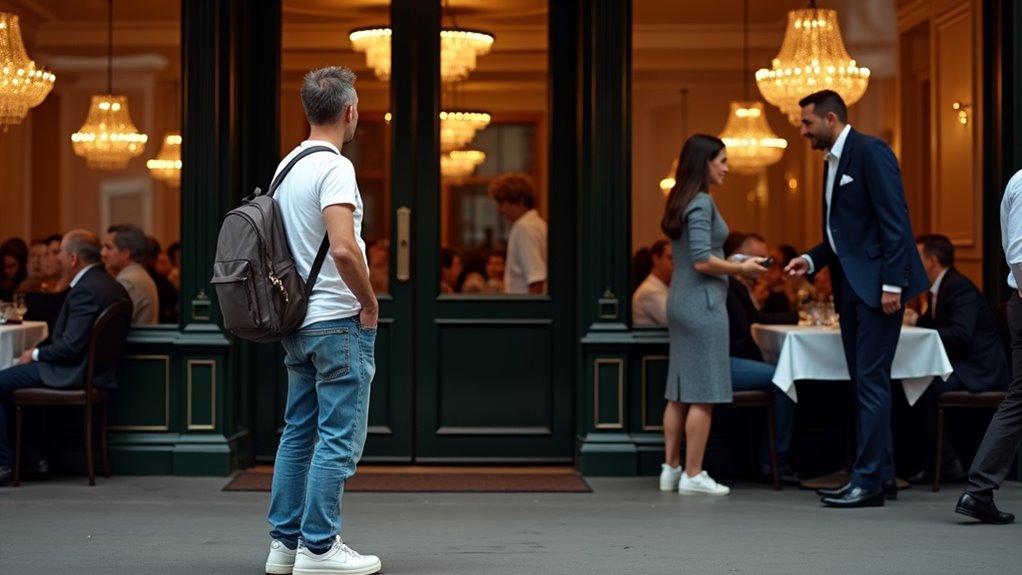
If you’re venturing into Paris’s upscale neighborhoods or planning elegant evenings out, your wardrobe choices matter considerably. Parisians dress with intention, especially in affluent areas where casual tourist attire can result in dismissive service or even denied entry.
For upscale Paris environments, remember:
The dress code extends beyond restaurants to luxury boutiques, where your attire influences how staff perceive you. Unlike the relaxed party atmosphere of Cyprus’s top nightlife destinations, Paris demands a more refined appearance in its sophisticated venues. Aim to embrace quality over quantity with well-constructed pieces that communicate sophistication. When in doubt, choose smart-casual over overly relaxed options to blend in with locals.
Understanding Parisian dining culture can make or break your experience in the City of Light. Arrive during standard meal times (lunch 12-2:30pm; dinner 8-10pm) to avoid limited menus or closed kitchens.
Always greet staff with “Bonjour” upon entering and maintain a lower speaking volume than you might at home.
For free water, ask for “une carafe d’eau” rather than bottled options.
Keep your hands visible on the table—not in your lap—and avoid resting your elbows on the surface.
Don’t expect to be seated immediately in cafés; wait for the “installez-vous” invitation. Unlike American restaurants, French dining establishments often allow customers to stay for hours, enjoying their meal at a leisurely pace without being rushed.
Remember that coffee comes after the meal, not during it, and you’ll need to explicitly request your bill when finished.
Service charges are included, so excessive tipping isn’t necessary.
If you enjoy exploring food cultures, you might find Zagreb’s culinary scene offers a refreshing contrast to Paris with its unique Central European flavors.
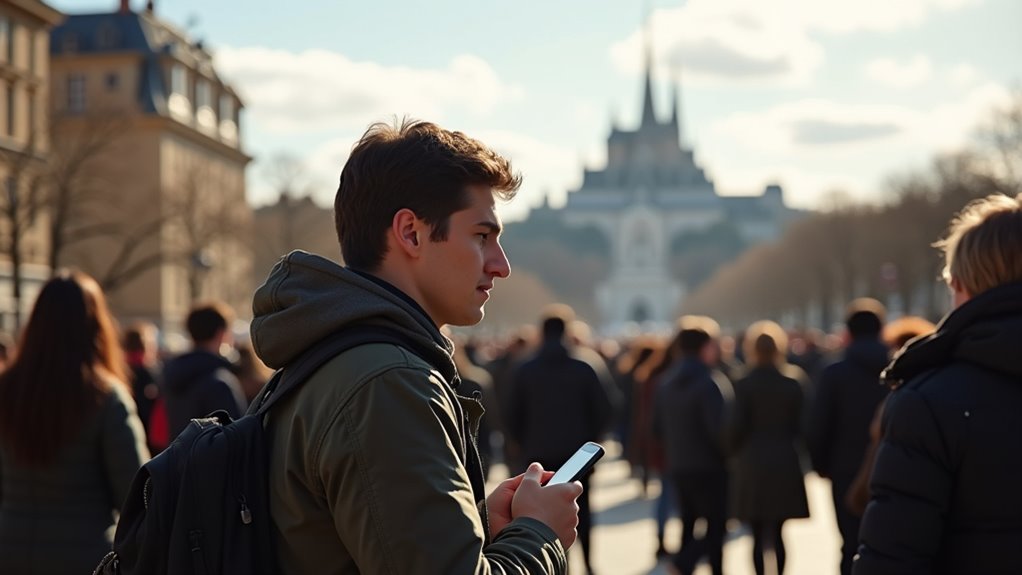
While savoring Parisian cuisine requires cultural awareness, protecting your belongings demands constant vigilance. Paris’s tourist hotspots like the Eiffel Tower, Sacré-Coeur, and busy metro lines are hunting grounds for organized pickpocket gangs who employ sophisticated distraction tactics.
Stay alert particularly when:
Remain vigilant in crowded spaces, during seemingly helpful interactions, and while distracted by Paris’s visual splendors.
Carry anti-theft bags worn across your body, keep valuables in front pockets or inside jackets, and establish a habit of regularly checking your belongings. Be wary of seemingly innocent interactions—many thefts begin with a friendly conversation or staged commotion designed to divert your attention while accomplices strike. When stopping at cafés to enjoy French iconic dishes, keep your bag on your lap rather than hanging it on your chair where it becomes an easy target. Remember that winter months offer slightly reduced risk, but pickpocketing occurs year-round in Paris regardless of season.
Beyond the Eiffel Tower and Louvre lies the soul of Paris—its vibrant neighborhoods that many travelers overlook. Don’t skip the historic covered passages of the 2nd arrondissement or Île de la Cité’s medieval architecture.
Le Marais offers Renaissance charm at Place des Vosges, while Canal Saint-Martin showcases industrial-era bridges and locks.
For local dining, explore rue Montorgueil’s pedestrian haven featuring Paris’ oldest patisserie, or try authentic falafel in Le Marais‘ Jewish quarter. The eclectic 11th arrondissement is now a hotspot for modern dining options, having transformed from its historical roots as a furniture-making district. While exploring, remember that Paris offers a Mediterranean atmosphere similar to parts of Greece and Croatia, especially in its outdoor café culture.
Skip the crowds by visiting Haut Marais early instead of on crowded Saturdays. The 3rd arrondissement’s shops remain open Sundays when others close.
Consider self-guided walking routes through hidden Le Marais courtyards, and save time by walking between nearby arrondissements instead of relying on taxis.
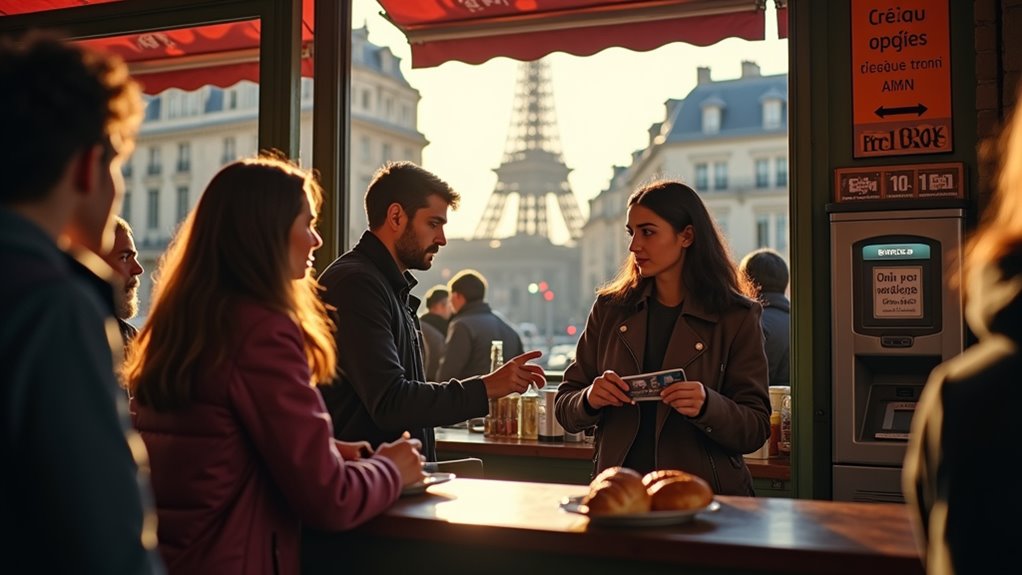
Despite Paris’s reputation as a modern European capital, many travelers are surprised to find that cash remains essential for daily transactions throughout the city. Many small shops, cafés, and bakeries maintain legal minimum purchase requirements of €5-15 for card payments, indicated by “CB à partir de X” signs. Markets and neighborhood vendors often accept only cash for purchases under €20. Food markets in particular typically require cash payment, with only high-value stalls sometimes offering card terminals.
Before exploring Paris, consider:
This hybrid approach guarantees you’ll navigate Paris smoothly without the frustration of declined cards or uncomfortable situations at small businesses.
As you navigate Paris’s charming streets, you’ll find that respecting local customs transforms your experience. Don’t rush through attractions or settle for tourist-trap restaurants. Explore neighborhoods on foot, remember to say “bonjour,” and keep some cash handy. Stay alert in crowds and embrace Parisian meal times. With these simple adjustments, you’ll experience the authentic Paris that locals cherish rather than the postcard version.